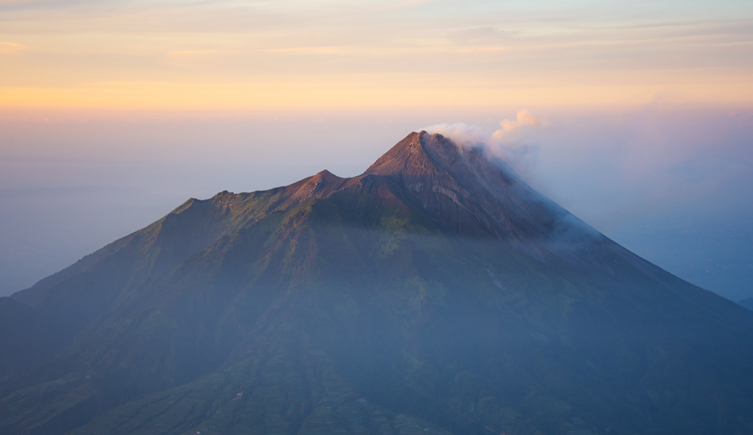Application details
Deadline to apply: Monday 20 January 2025

© yusuf madi/Shutterstock
Over recent years there has been a paradigm shift in understanding how magma is stored and the processes that mobilise magma and enable it to erupt.
Advances in microanalytical techniques have revealed that at convergent plate margin or subduction zone volcanoes in particular, magma is not stored in large liquid-rich chambers, but more commonly, as smaller, semi-solid, crystal-rich bodies distributed throughout the crust beneath such volcanoes.
For an eruption to take place, these stagnant reservoirs must first be primed and remobilised, via injections of new, hotter, volatile-rich magma from depth [1]. However, to date, questions remain around the conditions required to prime and trigger an eruption, and the timescales between priming and eruption onset.
In particular, how these processes occur at ‘hyperactive’ volcanoes, which are almost persistently active and which can switch their eruptive style between effusive and explosive activity with little warning, is poorly understood. Understanding these processes which lead to eruption and the timescales over which they operate is key to accurately monitoring volcanoes in a volcanic crisis.
New insights into magmatic processes can be revealed via micron-scale analysis of chemical zonation within crystals which grew in the magmatic system, and which thereby record key magmatic parameters such as temperature, pressure, and chemical composition. These data can also be input into cutting-edge diffusion chronometry models, in order to extract crucial information on the timescales over which these processes occur.
This PhD will reveal the pre-eruptive priming and triggering processes, as well as the timescales between priming and eruption, for both effusive and explosive eruptive styles at Merapi volcano (Indonesia). Merapi is a typical ‘hyperactive’ volcano, which is almost permanently active, and an ideal volcano to carry out this study. It is one of the most densely populated volcanoes on Earth, with 1.8 million people living on its slopes and at risk from eruptions. Over the last century, eruptions at Merapi have been dominated by the effusive growth of lava domes, which collapse to produce pyroclastic density currents [2]. However, as demonstrated by the large 2010 eruption, which killed > 300 people, Merapi can also erupt explosively [3]. Transitions between eruptive styles can occur quickly, enhancing the unpredictable nature of the activity. Understanding the processes and timescales producing an effusive dome-forming eruption vs. a larger explosive eruption is therefore a key priority in reducing risk in the region and for similar volcanoes worldwide. Although Merapi is a well-studied volcano and has a well-known eruptive history [4], the proposed magma storage is complex [4,5]. However, the cutting-edge microanalytical work which the student will undertake in this PhD will, for the first time at Merapi, unravel the precise histories of parcels of magma and provide timescales between injection and eruptions of different styles and sizes.
The successful candidate will have the opportunity to conduct fieldwork at Merapi and collect samples from eruptions with known sizes / styles, in collaboration with the Centre for Volcanology and Geological Hazard Mitigation (CVGHM) in Indonesia (optional). The samples will then be characterised by the student in terms of their whole rock geochemistry (XRF, ICP-MS), and petrography (light microscopy, SEM). The student will reconstruct magmatic conditions and processes by defining and chemically analysing crystal populations based on their compositional zoning patterns, which record their growth history in the magmatic reservoir (SEM, electron microprobe, LA-ICPMS). The student will then select suitable crystals for state-of-the-art diffusion modelling [6], to establish timescales between priming and eruption. The candidate will join the well-established Volcanoes and Tephra research group within the Department of Geography at Swansea University and will benefit from working within a network of national and international collaborators.
A comprehensive training programme will be provided, comprising specialist scientific training, and transferable professional skills. The student will learn volcanological field techniques during fieldwork (optional as samples are available).
The student will be trained in geological sample preparation techniques, optical and electron microscopy (Swansea), whole-rock geochemical analysis including XRF and ICP-MS (Swansea; Keele), chemical microanalysis using electron microprobe and LA-IPCMS (NHM), and diffusion modelling (NHM).
The student will undertake Swansea- and CROCUS-based training in transferable research skills. They will present at national and international conferences, placing the student at the forefront of the discipline, leading to excellent future employment opportunities.
This project would be suitable for students with an Undergraduate or Masters degree in Geology, Geoscience, or other closely-related subject.
Deadline to apply: Monday 20 January 2025
Swansea University

.png)